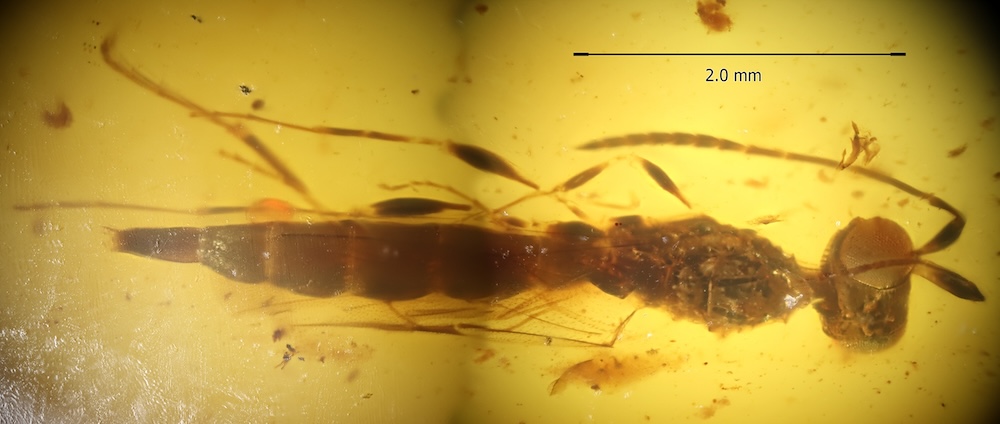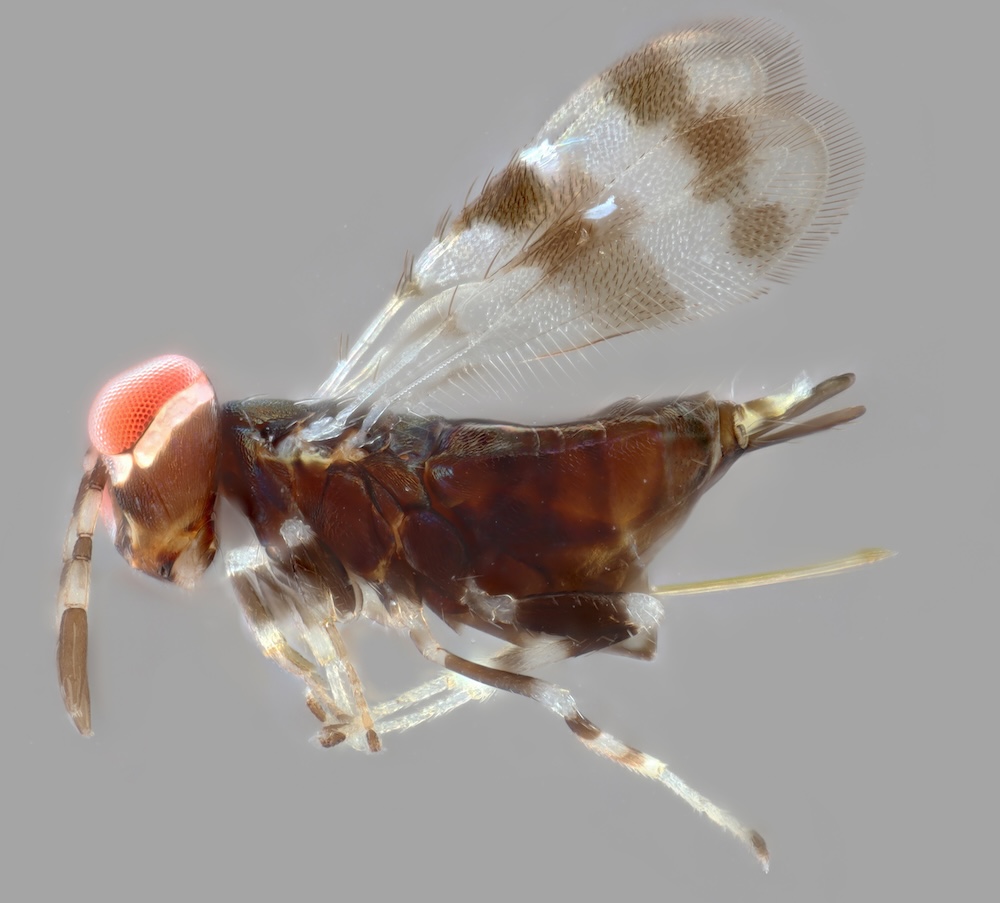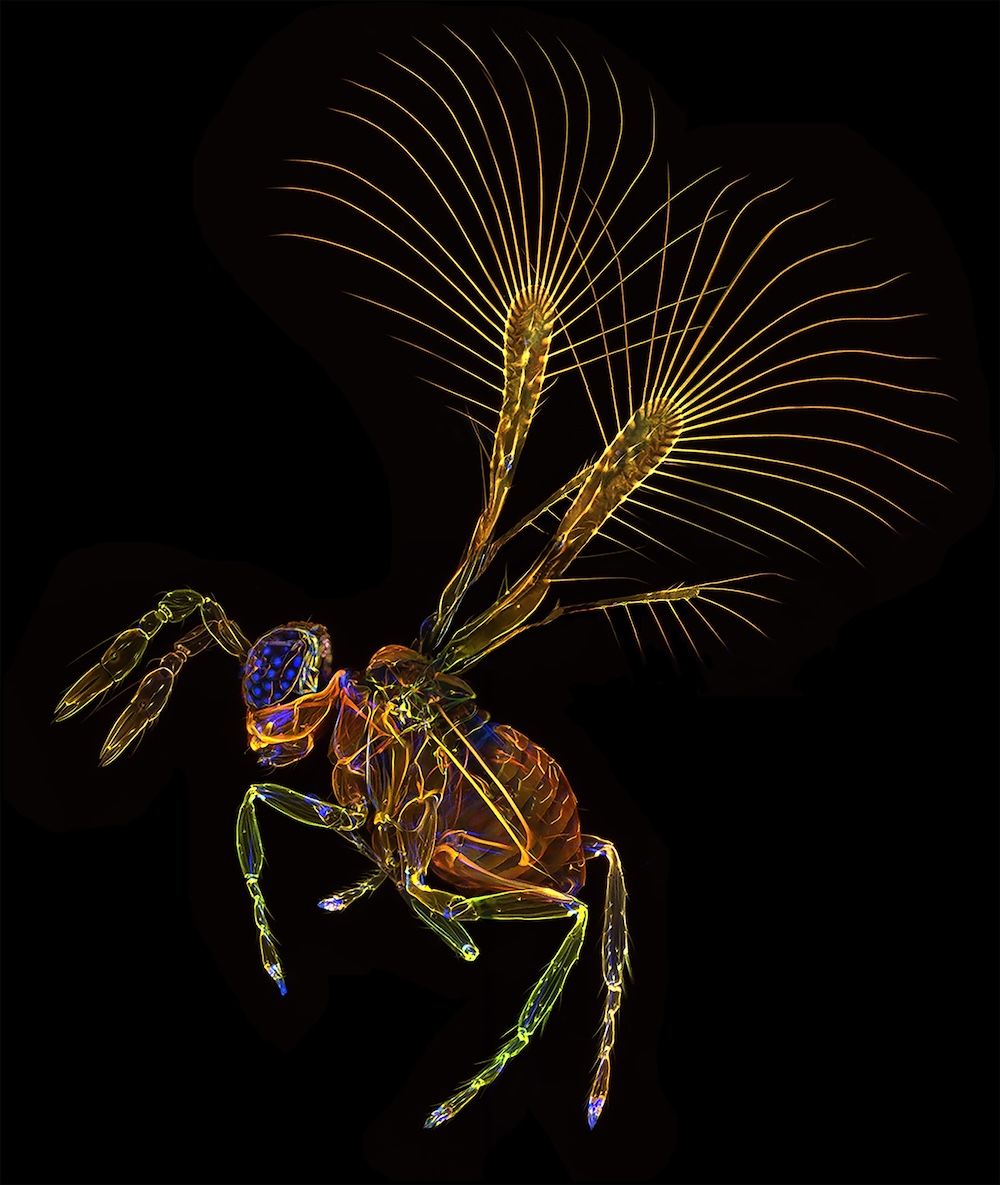As the Royal Entomological Society marks Insect Week – a celebration of all things insect — Saskia McCracken journeys into the microscopic world of miniature wasps.

Wasp in Amber, Sparasionidae. Photo credit: Andrew Polaszek, Natural History Museum
I’m holding a piece of amber the size of a marble in my palm. There’s a tiny wasp suspended in the centre. Both are over one hundred million years old. I place the amber under the microscope and adjust the lens, so the image comes into focus. There are tiny bubbles of Cretaceous air trapped inside this honey-gold world. I can see the wasp clearly, antennae reaching, the fine detail of each wing, delicate as lace, spread as if in flight. Its abdomen hangs low, bronze, a whisper of a sting at the end. The eyes, unseeing, once gazed upon dinosaurs. She was hunted by the first birds and early mammals, hummed her way into the hearts of the first flowers. And, while many creatures she lived alongside are long extinct, her descendants are still here today. Her kind, Sparasionidae, is one of at least a hundred thousand species of wasp that still exists. Just as she was found in Burmese amber, so her fellows continue to buzz around that country, small and mostly unnoticed.
The wasp I’m looking at is far from home, both temporally and geographically. We’re in the Natural History Museum in London, “Nature’s cathedral.” I had passed through the heart of the building to get to this wasp. Where the altar would be in a religious building, the great hall of this elaborate Romanesque structure ends in a broad staircase with a statue of Charles Darwin at the centre. The walls are lined with huge archways containing displays of striking beauty from the natural world, a glittering black and gold meteorite, giant bleached coral, a stuffed giraffe, a blue marlin with blank eyes, big enough to swallow me whole. Presiding over it all, suspended from the arched ceiling, the skeleton of a blue whale. The only evidence of wasps the public can see is on the balcony above the hall – a bowler hat containing a long abandoned wasp nest. While this hall, filled with tourists from all over the world, demonstrates some of the biggest, most spectacular wonders in the collections, I’m now behind the scenes, looking at some of the museum’s smallest specimens.
I’m with Andrew Polaszek, a taxonomist whose job includes identifying and describing new species and genera of wasps. He visited the museum when he was seven years old knew immediately that he wanted to work here. But they aren’t all waiting for him, preserved in amber. Most have to be caught before he can study them. He shows me the tools of his trade. Besides the microscope, he has a huge triangular net, like a butterfly net with mesh covering the opening. Nothing bigger than four millimetres can get in. The net looks like it belongs to a Victorian naturalist chasing bright wings through a tropical jungle. This image isn’t far off the truth. Andrew and his colleagues go to species rich places all over the world, including Madagascar, Borneo, Mexico and Costa Rica. They sweep their nets to and fro along the ground, gathering little insects, mostly too small to see. He tells me that if I were to spend half an hour sweeping a net like this in the forests of Mexico, I could easily catch a thousand unnamed species. One of the exciting things about insects is that there are so many still to discover. We can probably say that we’ve identified all of the elephants, tigers and rhinos in the world. But there could well be several million unidentified insects all around us.

Ablerus (female of an undescribed species from South Africa). Photo credit: Suhaib Yatoo, Natural History Museum
He introduces me to one of his former students, Suhaib Yatoo, who recognised twenty-eight new species of Ablerus wasp during his postdoctoral research. They show me pictures in incredibly high resolution of these stunning insects. Wasps aren’t all yellow and black striped. These are iridescent blue-green, with golden shimmering wings, black and white striped antennae, red eyes covered in a thin veil of white, stunning as a peacock’s feathers. Just as only some wasps are striped, so only some wasps bother humans with their stings when they disrupt our picnics and barbecues. The rest are a mixture of pollinators, predators and parasitoids who hunt the insects that ravage our crops, and are an effective form of pest control, saving the agricultural industry millions of dollars each year. Andrew calls them ‘nature’s little heroes.’
But the wasps Andrew studies are even smaller than these multi-coloured Ablerus. He’s recently been identifying different species of Megaphragma, which are around a fifteenth of a millimetre. You can hardly see them with the naked eye, yet they are all around the world, all around us. Although even they can be hunted with the net, his preferred strategy is to target their hosts. Many wasps lay their eggs in host insects like caterpillars and flies. When the larvae hatch, they have plenty to feed on. So Andrew collects the Megaphragma’s host, the eggs of an insect known as the thunderfly.
He puts the eggs in a ‘rearing cage’ inspired by a face cream jar. They are cheap and easy to get hold of, so he says I can keep this one as a memento of my visit. The object he hands me doesn’t look much like a cage. It’s a little black plastic tub. Sticking out of the top is a clear plastic tube. I look closer. Within the tube is a clear plastic funnel, the narrow point facing upwards. The host stays in the tub, too big to fit in the funnel. The Megaphragma, once it has transformed from larva into a miniscule, winged insect, flies towards the light, from the dark of the tub, up through the funnel, into the tube. Andrew then takes these barely-there wasps, just black dots against the clear plastic, and preserves them in alcohol. After careful DNA extraction, the still-perfect wasps are placed in Canadian balsam, resin from a fir tree. A bit like the wasp in amber, which was preserved in resin by accident. Historic butterfly nets, prehistoric resin, are both still useful to naturalists today. He shows me a little golden disc that contains a Megaphragma. The insect is so small that it seems invisible to me.

Confocal laser micrograph of Megaphragma longiciliatum (female from Oman; total length 0.25 mm). Photo credit: Andrew Polaszek, Natural History Museum
Under the microscope, a creature takes shape in the centre of the disc. Each limb finer than human hair. Each segment of the antennae. The wings splay out like a pterodactyl fossil, the edges impossible to see, even now. Like a fan without its silk. I wonder what has this insect has seen. Not dinosaurs, but a microscopic world teeming with unnamed life. Creatures we may never discover. We find many new kinds all the time, but insect species are also going extinct at a faster rate than ever before. Andrew and his team don’t want them to exist solely in museums. Fossils in amber. I don’t like getting too close to live wasps, but I don’t want them to disappear completely. The more we know about insects, the better our chances of being able to do something to prevent them from becoming invisible forever. If we understand them we can protect their habitats. Then this magical, miniature world can thrive, iridescent bodies flitting between leaves, golden wings shimmering through the air.
With thanks to Andrew Polaszek, Suhaib Yatoo, and the Natural History Museum.
*
Saskia McCracken is a writer based in Glasgow, represented by Jenny Brown Associates. She was shortlisted for the Future Places Environmental Essay Prize and longlisted for the Nature Chronicles Prize. Her debut short story collection ‘Zero Hours‘ was published by Broken Sleep Books (2021). She is currently working on a nonfiction book, ‘Awful Creatures’, about why we should care for underappreciated animals like rats, wasps and pigeons. Her book research, including for this essay, is supported by Creative Scotland and the Alice McCosh Trust.